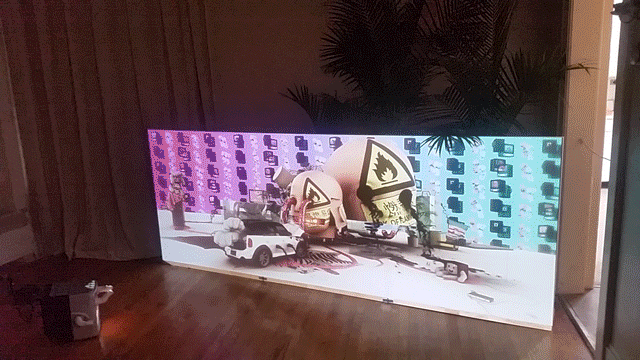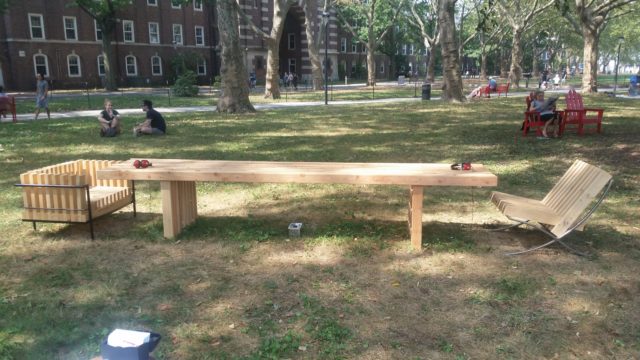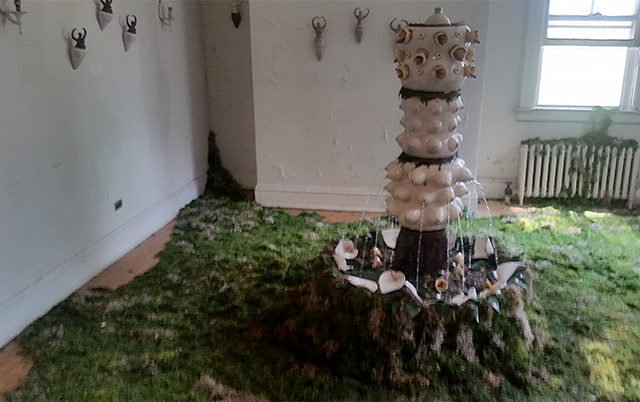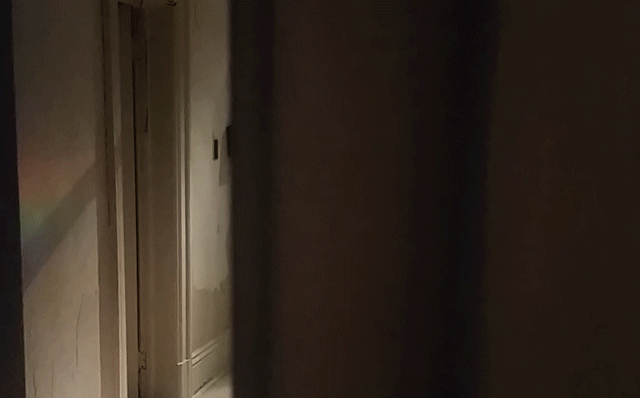
Julia Sinelnikova, “Saṃjñā ⌘,” at the Holocenter. Image courtesy of the artist.
For better or for worse, the spirit of the 9th annual Governor’s Island Art Fair could most accurately be described as “quirky.” There’s plenty of inscrutable colorful blobs, a seemingly hands-off curatorial approach, and at least one artist statement written in the font Papyrus.
But the wildly-uneven art fair, which is organized by artist-run nonprofit 4heads, is kinda great because of its unpredictable weirdness. Schlocky acrylic paintings might share a room with ambitious installations or obsessively-crafted ceramics. The whole experience is made stranger by the context of Governor’s Island—where decaying officer housing and abandoned institutional buildings give the place a vibe akin to a sprawling haunted house set in a post-apocalyptic Ivy League campus. And of the art fairs only accessible by ferry, this certainly feels the most democratic. Admission is free, and the 100 international artists seem to have pretty free reign. By and large, the most successful projects were those that embraced the loaded site-specificity of the island.

Wang Ye-Feng
Wang Ye-Feng installed video screens of various sizes, houseplants, and furniture in one of the derelict living rooms. His digital animations feature cars and toys spewing oil, toxic-looking baby dolls and consumer goods, and a hyper-saturated color palette. I’m not sure I would’ve like this work had it not been for the context—baby doll heads are usually a good indicator of bad art—but here the content staged in a ruined domestic space felt appropriately like a sci-fi set for a bleak production.

Matthias Neumann, “masters (basics)”
Matthias Neumann’s outdoor picnic set-up was a bit of a head-scratcher. Iconic chairs from Corbusier and Mies van der Rohe, recreated in 2x4s, sat opposite one another with headphones. The arrangement suggested a dialogue, but the headphones were playing some old-timey sounding pop music in a language I couldn’t place. After a minute sitting at the table I felt the urge to leave. Was my response was due to the wooden furniture being considerably less comfortable than its leather inspirations, or the awkwardness of sitting alone at an oversized table for two in public? I couldn’t tell and still can’t decide if this was a good or bad sign.

Cody Brgant
Cody Brgant wrapped every surface in one of the Colonel’s Row kitchens in white paper and produces rubbings of the details below. This was impressive for the absolute commitment to cover and document absolutely every detail, from the radiator to a fruit bowl. Standing here, I couldn’t stop thinking about how huge this kitchen (and the homes in general) were by New York standards. Interventions such as this one really drove home the surrealness of these huge, un-lived in homes minutes from Lower Manhattan.

Rosanne Ebner
Rosanne Ebner’s fountain of breasts watering living plants in another room also spoke to the bizarre state of decay on the decommissioned military base—in another hypothetical future, these structures will slowly return to a forest.

Ana Maria Nicholson
But the real highlight of a trip to Colonel’s Row is the Holocenter: Center for Holographic Arts. The institution is one of the few semi-permanent tenants in the complex, and is certainly one of the most unique arts organizations in the city. Holocenter has been preserving and exhibiting decades worth of holograms, such as 1980s portraits by Ana Maria Nicholson, including the above image of Keith Haring. I came to a somewhat morbid realization that these holograms are likely the most detailed records available of what some deceased people looked like.

Dr. Martina Mrongovius
The hologram has a inherently site/time-based component that can be used to great theatrical effect. Upstairs, for example, this nearly life-size hologram by Dr. Martina Mrongovius is so creepy at the end of a dilapidated hallway I almost didn’t want to look at it. The figure glides like a ghost in the opposite direction of a viewer walking by, and seems to disappear into the adjacent doorway.

Julia Sinelnikova, “Saṃjñā ⌘,” image courtesy of the artist.
The Holocenter also commissions temporary installations, such as Julia Sinelnikova’s “Saṃjñā ⌘,” which will be on view until Sunday, September 25th. The piece is a suspended latticework of meticulously hand-cut holographic mylar with a video projection. The video is refracted into hundreds of reflections and abstracted nearly beyond the point of clarity, but its content is again unique to the island. Sinelnikova filmed herself dancing with another of her pieces in the dungeon-like armory of the nearby fort. Even the lace-like pattern on the foil is based on the tree canopy of the island. It’s transfixing, and utterly transforms the former bedroom into something totally alien using locally-sourced imagery.
Sinelnikova’s piece, and the Governor’s Island Art Fair, come down this weekend. It’s definitely worth the $2 boat ride to check them both out. The ferry leaves from Lower Manhattan or the Brooklyn Bridge Park every hour, and the exhibitions are open from 11 a.m. to 6 p.m.


Comments on this entry are closed.